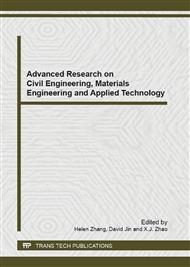p.289
p.293
p.298
p.304
p.309
p.315
p.322
p.329
p.333
Theoretical and Experimental Research on Load Transfer of Anchorage Stress in Soil Anchor
Abstract:
The shear stress transfer of prestressed anchor is the key for anchor performance and engineering design. The interface bonding strength between soil and induration has a very important role in supporting capacity of the soil anchor. It is presumed that the deformation between the soil layer rod and induration is compatible after the sliding section. Based on the Mindlin solution of a force act on the interior of a semi-infinite solid, a theory solution for the shear load of anchorage section is solved by considering the part of slip characteristics of interface in the loading process. On this basis, the shear stress of anchorage section is tested from anchor pullout test on site. Contrasted with the tests result, it is proved that the theoretical analysis is consistent with the tests. Theoretically, the research of shear stress transfer will enrich and develop anchor cable theory.
Info:
Periodical:
Pages:
309-314
Citation:
Online since:
December 2013
Authors:
Keywords:
Price:
Сopyright:
© 2014 Trans Tech Publications Ltd. All Rights Reserved
Share:
Citation:


